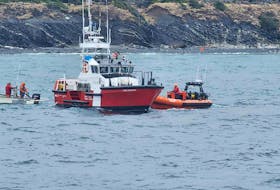ST. ANTHONY, NL – The regional government consultation in St. Anthony spawned lots of debate, few easy answers, and some consensus.
Local leaders attended the session hosted by the provincial government at the Grenfell Interpretation Centre on Oct. 23.
They came from St. Anthony and area, St. Lunaire-Griquet, Roddickton-Bide Arm and area, and the Straits for the consultation.
Many difficult questions were posed on the nature of regional government. At the four different discussion tables, conversation and debate were nonstop.
However, in some areas there was consensus, including on the boundaries for regional government on the Northern Peninsula.
Municipal leaders agreed that three or four regions would work best from River of Ponds to the north due to the geography and population dispersion.
Consensus suggested there would be four regions: the St. Anthony Basin Resource Inc. region, Eddies Cove East to Castor River South, Main Brook to Englee, and Eddies Cove West to River of Ponds.
These are the NorPen Waste Management sub-regions.
This mapping for regional government on the Northern Peninsula contrasted sharply with the provincial government’s proposal for one regional government for the entire area.
The province’s proposal was based on population but municipal leaders feel it did not take into account the geography of the Northern Peninsula.
They pointed out that the Northern Peninsula is unique compared to most of the province due to its lower population density.
Government’s proposed area for regional government would be bigger and the population more spread out than almost any other in the province.
According to participants, this would be difficult to coordinate.
Therefore, they request smaller regional governments where it would be easier for four different clusters of communities to coordinate and work together.
Little consensus
According to information accumulated and presented at the end of the session, a number of different ideas were bandied about as to how regional governments should raise revenue to pay for services.
On this subject, there was little consensus.
Ideas included: a set fee/flat rate for all residents, different forms of taxation, fees for services, local revenue generation such as Chase the Ace, and giving Crown land to the region to sell, amongst others.
Various advantages and disadvantages of all municipalities, local service districts, and unincorporated areas being part of a regional government system were also highlighted.
Advantages included more and better services and access to funding for local service districts, equalization of services, giving everyone a voice in government, increased participation amongst residents, and increased commitment by volunteers.
Disadvantages highlighted included increased costs for services, increased taxes and fees, too many views and ideas, boards becoming too large to handle, and one centre possibly getting services over another.
There was agreement that local service districts and unincorporated areas shouldn’t be given the option to opt out of a regional government, but municipalities could.
The session in St. Anthony was the 19th of 22 hosted by the province’s Department of Municipal Affairs and Environment. About 27 people attended.
Per a department press release, the consultation process sought public input to help inform the development of a potential regional government model for the province.
The consultations ended on Oct. 26.
Regional government would be implemented by 2019.








